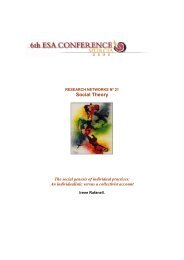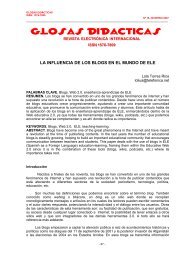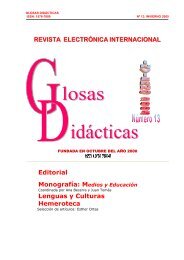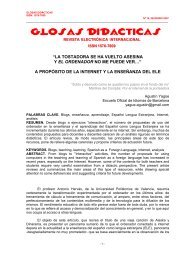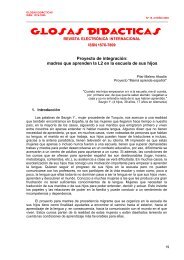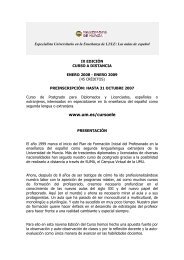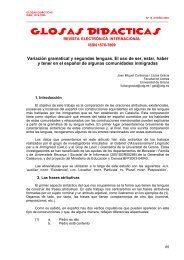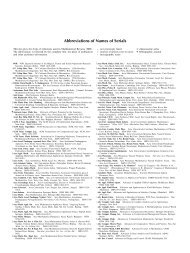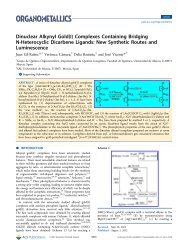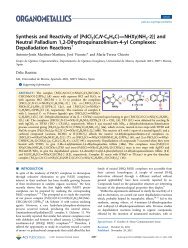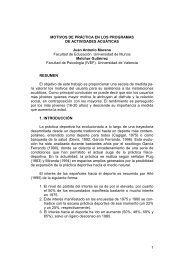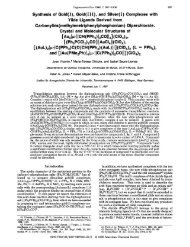Synthesis, Isolation, and Characterization of an Organometallic ...
Synthesis, Isolation, and Characterization of an Organometallic ...
Synthesis, Isolation, and Characterization of an Organometallic ...
Create successful ePaper yourself
Turn your PDF publications into a flip-book with our unique Google optimized e-Paper software.
COMMUNICATION<br />
pubs.acs.org/IC<br />
<strong>Synthesis</strong>, <strong>Isolation</strong>, <strong><strong>an</strong>d</strong> <strong>Characterization</strong> <strong>of</strong> <strong>an</strong> Org<strong>an</strong>ometallic<br />
Triiodopalladium(IV) Complex. Qu<strong>an</strong>titative <strong><strong>an</strong>d</strong> Regioselective<br />
<strong>Synthesis</strong> <strong>of</strong> Two C I Reductive Elimination Products<br />
Jose Vicente,* ,† Aurelia Arcas, † Fr<strong>an</strong>cisco Julia-Hern<strong><strong>an</strong>d</strong>ez, † <strong><strong>an</strong>d</strong> Delia Bautista ‡<br />
† Grupo de Química Org<strong>an</strong>ometalica, Departamento de Química Inorg<strong>an</strong>ica, Facultad de Química, <strong><strong>an</strong>d</strong> ‡ SAI, Universidad de Murcia,<br />
Apartado 4021, E-30071 Murcia, Spain<br />
bS Supporting Information<br />
ABSTRACT: Iodine <strong><strong>an</strong>d</strong> the pincer complex [Pd(O,N,C-<br />
L)I], where L is the mono<strong>an</strong>ionic lig<strong><strong>an</strong>d</strong> resulting from<br />
deprotonation <strong>of</strong> the acetyl group <strong>of</strong> the dimethylmonoketal<br />
<strong>of</strong> 2,6-diacetylpyridine, are in equilibrium at low temperatures<br />
with the palladium(IV) complex [Pd(O,N,C-L)I 3 ],<br />
which c<strong>an</strong> be isolated at 40 °C <strong><strong>an</strong>d</strong> characterized by 1 H<br />
NMR spectroscopy <strong><strong>an</strong>d</strong> X-ray diffraction studies, in spite <strong>of</strong><br />
its great instability. When the same reaction is carried out at<br />
room temperature, a qu<strong>an</strong>titative reductive elimination<br />
process occurs, giving L I, which in the presence <strong>of</strong> water<br />
affords L 0 I, resulting from hydrolysis <strong>of</strong> L I.<br />
The number <strong>of</strong> fully characterized org<strong>an</strong>opalladium(IV) complexes<br />
reported is increasingly growing in recent years in<br />
parallel with the interest for their use in catalytic <strong><strong>an</strong>d</strong> stoichiometric<br />
org<strong>an</strong>ic reactions. The difficulty <strong>of</strong> preparing, isolating,<br />
<strong><strong>an</strong>d</strong> characterizing such complexes st<strong><strong>an</strong>d</strong>s on their spont<strong>an</strong>eous<br />
tendency to undergo reductive elimination processes to give<br />
palladium(II) complexes <strong><strong>an</strong>d</strong> C CorC X (X = halogen,<br />
RCO 2 ) coupling products, which accounts for their applications<br />
in org<strong>an</strong>ic synthesis. 1 3<br />
Since the synthesis <strong>of</strong> the first org<strong>an</strong>opalladium(IV) complexes<br />
by Uson et al. in the 1970s, by reacting perfluorophenylpalladium(II)<br />
complexes with chlorine, 4 only a very recent<br />
studies devoted to obtaining palladium(IV) complexes by using<br />
dihalogens, PhIX 2 or XeF 2 , have succeeded in giving oxidative<br />
addition products stable enough to be isolated <strong><strong>an</strong>d</strong> characterized<br />
by X-ray diffraction: [PdF 2 (C^N)(N^N)] (X^Y is <strong>an</strong> X,Y mono<strong>an</strong>ionic<br />
chelating lig<strong><strong>an</strong>d</strong>), 5 [PdCl 2 (C^N)(C^O)], 6 [PdF 2 (FHF)-<br />
(C 6 H 4 F-4)(N∼N)] (X∼Y is <strong>an</strong> X,Y neutral chelating lig<strong><strong>an</strong>d</strong>), 7<br />
[PdBr 2 (C^N^N)(CN t Bu)] (X^Y^Z is <strong>an</strong> X,Y,Z mono<strong>an</strong>ionic<br />
tridentate lig<strong><strong>an</strong>d</strong>), 2 <strong><strong>an</strong>d</strong> [PdX 3 (C^N^O)] (X = Cl, Br). 3 Neutral<br />
monohalo derivatives [PdX(C^C)(N^N^N)] (X = Cl, Br, I) are<br />
the isolated products when the halogen is reacted with some<br />
<strong>an</strong>ionic complexes. 8 In the me<strong>an</strong>time, most <strong>of</strong> the reported<br />
reactions <strong>of</strong> this type in which the palladium(IV) complex has<br />
been isolated but not characterized by X-ray diffraction, 9 not<br />
isolated, 10,11 or even not detected, 12 have been used to prepare<br />
the corresponding C X coupling products resulting from the<br />
reductive elimination process.<br />
The above results set I 2 quite apart from the other halogens.<br />
In fact, the only reported org<strong>an</strong>ometallic diiodopalladium(IV)<br />
complexes are [PdI 2 Me(R)L 2 ](L 2 = bidentate nitrogen donor<br />
lig<strong><strong>an</strong>d</strong>s; R = Me, Tol), prepared by reacting I 2 with [PdMe(R)L 2 ],<br />
which decomposes in solution or upon attempted isolation. 13,14<br />
The sulfur ylide complex [Pd{(CH 2 ) 2 S(O)Me} 2 ] reacts with I 2 to<br />
afford the unstable complex [Pd{(CH 2 ) 2 S(O)Me} 2 I 2 ], 15 which<br />
was characterized only by elemental <strong>an</strong>alysis. Even palladium(IV)<br />
complexes with only one iodo lig<strong><strong>an</strong>d</strong>, usually obtained by the<br />
oxidative addition <strong>of</strong> alkyl iodides to alkylpalladium(II) complexes,<br />
are unstable when isolated or only detected in solution. 13,16<br />
At difference with dihalopalladium(IV) complexes, which<br />
decompose to give the C X reductive elimination products,<br />
monohalopalladium(IV) complexes usually decompose through<br />
C C coupling processes. Only one such complex, fac-[PdMe 3 I-<br />
(bpy)], has been characterized by X-ray diffraction. 17 When<br />
these data on palladium(IV) complexes are compared with those<br />
<strong>of</strong> the corresponding platinum(IV) complexes, the great differences<br />
between both d 6 ions are evident. For example, m<strong>an</strong>y<br />
Pt IV I n complexes (n =1 6), in particular stable triiodo complexes,<br />
have been isolated. 18<br />
We have recently reported the synthesis <strong>of</strong> the pincer<br />
complexes [Pd(O,N,C-L)X], 3,19a where X = Cl, Br <strong><strong>an</strong>d</strong> L is<br />
the mono<strong>an</strong>ionic lig<strong><strong>an</strong>d</strong> resulting from deprotonation <strong>of</strong> the<br />
monoketal <strong>of</strong> 2,6-diacetylpyridine (dap), <strong><strong>an</strong>d</strong> its use to prepare<br />
palladium(IV) complexes [Pd(O,N,C-L)X 3 ](X=Cl,Br)<br />
by reacting them with Cl 2 or Br 2 . 3 Because this pincer lig<strong><strong>an</strong>d</strong><br />
provides these complexes with a remarkable stability, we<br />
considered the synthetic challenge <strong>of</strong> completing the series<br />
by preparing the triiodopalladium(IV) complex [Pd(O,N,C-<br />
L)I 3 ](2), whose stability was predicted to be very precarious<br />
considering all <strong>of</strong> the above data.<br />
The reaction <strong>of</strong> [Pd(O,N,C-L)Cl] with NaI afforded qu<strong>an</strong>titatively<br />
[Pd(O,N,C-L)I] (1; Scheme 1). The reaction at 40 °C,<br />
under N 2 , between a CH 2 Cl 2 solution <strong>of</strong> 1 <strong><strong>an</strong>d</strong> I 2 (1:1.25 molar<br />
ratio) gave a very dark solution, which upon slow diffusion <strong>of</strong><br />
Et 2 O <strong><strong>an</strong>d</strong> st<strong><strong>an</strong>d</strong>ing for 5 days at 33 °C gave black single crystals<br />
<strong>of</strong> the triiodopalladium(IV) complex 2. Although crystalline solid<br />
2 shows no noticeable decomposition after 1 month at 33 °C,<br />
the amorphous solid decomposes immediately at 20 °C, preventing<br />
us from obtaining good elemental <strong>an</strong>alyses. However, 2<br />
has been characterized by 1 H NMR spectroscopy <strong><strong>an</strong>d</strong> X-ray<br />
crystallography (see below). This result contrasts with that<br />
obtained in the related reaction between [Pd(N^C^N)I]<br />
{N^C^N = 2,6-bis[(dimethylamino)methyl]phenyl) <strong><strong>an</strong>d</strong> I 2 ,<br />
Received: April 4, 2011<br />
Published: May 25, 2011<br />
r 2011 Americ<strong>an</strong> Chemical Society 5339 dx.doi.org/10.1021/ic2006869 | Inorg. Chem. 2011, 50, 5339–5341
Inorg<strong>an</strong>ic Chemistry<br />
COMMUNICATION<br />
Scheme 1<br />
which affords [Pd(N^C^N)I 333 (I 2 ) 2 ] containing two molecules<br />
<strong>of</strong> I 2 interacting with the iodo lig<strong><strong>an</strong>d</strong> at a dist<strong>an</strong>ce <strong>of</strong><br />
Figure 1. Ellipsoid representation <strong>of</strong> 2 (50% probability).<br />
3.3 Å 19b . This complex is a possible model for the initial stage in The tendency <strong>of</strong> 2 to disproportionate into the reagents used to<br />
the formation <strong>of</strong> 2, although <strong>an</strong>other with a Pd 333 I 2 interaction,<br />
such as has been described for the homologous platinum- to its homologues trichloro <strong><strong>an</strong>d</strong> tribromo complexes 3 <strong><strong>an</strong>d</strong> other<br />
prepare it, 1 <strong><strong>an</strong>d</strong> I 2 , represents <strong>an</strong> essential difference with respect<br />
(II) pincer complex, 20 c<strong>an</strong>not be discarded.<br />
org<strong>an</strong>ometallic palladium(IV) complexes with the only exception<br />
The reaction <strong>of</strong> 1 with 1 equiv <strong>of</strong> I 2 was followed by 1 H NMR shown above. 24 This c<strong>an</strong> be considered normal for <strong>an</strong> org<strong>an</strong>ometallic<br />
complex <strong>of</strong> a highly oxidizing metal center, palladium(IV),<br />
in CD 2 Cl 2 <strong><strong>an</strong>d</strong> CDCl 3 at various temperatures. At room temperature,<br />
the spectra <strong>of</strong> the reaction mixtures showed full <strong><strong>an</strong>d</strong> bonded to three reducing lig<strong><strong>an</strong>d</strong>s like I <strong><strong>an</strong>d</strong> is in line with our<br />
almost immediate decomposition <strong>of</strong> 2 to the C I coupling initial skepticism on the success <strong>of</strong> the synthesis <strong>of</strong> 2.<br />
product, L I(3; Scheme 1), <strong><strong>an</strong>d</strong> precipitation <strong>of</strong> a black solid, The 1 H NMR spectrum <strong>of</strong> complex 1 shows the equivalence <strong>of</strong><br />
identified as PdI 2 . Therefore, the room temperature reaction <strong>of</strong> a the MeO groups <strong><strong>an</strong>d</strong> that <strong>of</strong> the CH 2 protons at room temperature,<br />
while at 33 °C, the corresponding signals are broad. In the<br />
CHCl 3 solution <strong>of</strong> 1 with 1 equiv <strong>of</strong> I 2 allowed the qu<strong>an</strong>titative<br />
<strong><strong>an</strong>d</strong> regioselective isolation <strong>of</strong> 3. When this reaction was carried chloro <strong><strong>an</strong>d</strong> bromo derivatives, the equivalence <strong>of</strong> the MeO <strong><strong>an</strong>d</strong><br />
out in the presence <strong>of</strong> water, using MeCN as the solvent, CH 2 protons is maintained even at 60 °C, which shows that the<br />
hydrolysis <strong>of</strong> 3 took place, allowing the qu<strong>an</strong>titative <strong><strong>an</strong>d</strong> regioselective<br />
isolation <strong>of</strong> compound 4. We could not isolate the halide homologues. In contrast to 1, the MeO <strong><strong>an</strong>d</strong> CH 2 protons<br />
Pd OMe bond is stronger in the iodo complex 1 th<strong>an</strong> in its<br />
chloro <strong><strong>an</strong>d</strong> bromo homologues <strong>of</strong> 3, from the corresponding <strong>of</strong> 2 at 33 °C are observed as two singlets <strong><strong>an</strong>d</strong> <strong>an</strong> AB system,<br />
palladium(IV) complexes because they quickly hydrolyzed to respectively, which reveals the stronger Pd OMe bond in the<br />
give the corresponding homologues <strong>of</strong> 4. 3 The only reported palladium(IV) complex 2 with respect to the palladium(II)<br />
halogen derivative <strong>of</strong> dap is the symmetric dibromo-2,6-diacetylpyridine<br />
obtained by bromination. 21<br />
deshielded (6.29 <strong><strong>an</strong>d</strong> 6.01 ppm) with respect to that in 1 (3.49<br />
complex 1. TheCH 2 protons in complex 2 appear highly<br />
Complexes <strong>of</strong> iron(II) <strong><strong>an</strong>d</strong> cobalt(II) with bis(imino) derivatives<br />
<strong>of</strong> dap are highly active catalysts for the polymerization <strong><strong>an</strong>d</strong> derivatives.<br />
ppm), which was also observed in the chloro <strong><strong>an</strong>d</strong> bromo<br />
oligomerization <strong>of</strong> olefins. Compound 4 <strong><strong>an</strong>d</strong> derivatives prepared The structure <strong>of</strong> complex 2 (Figure 1) 25 is similar to those <strong>of</strong><br />
by replacing iodine could be used to synthesize new catalysts with its chloro <strong><strong>an</strong>d</strong> bromo homologues. 3 The main difference (apart<br />
unsymmetrical dap derivatives. 22<br />
from the Pd X bond dist<strong>an</strong>ces) is the Pd N bond length, which<br />
Although palladium(IV) intermediates have been invoked in is longer in 2 [2.045(3) Å] th<strong>an</strong> in the other [PdLX 3 ] complexes<br />
some reactions between alkylpalladium(II) complexes <strong><strong>an</strong>d</strong> I 2 , {X = Br [2.0207(15) Å], Cl [2.0058(15) Å]}, according to the<br />
affording C I coupling products, they have not even been tr<strong>an</strong>s influence scale I > Br > Cl. 26<br />
detected in solution. 11 The same occurs with the diiodination In conclusion, we have studied (1) the reaction between <strong>an</strong><br />
<strong>of</strong> some arenes using Pd(OAc) 2 as the catalyst <strong><strong>an</strong>d</strong> IOAc as the org<strong>an</strong>ometallic palladium(II) pincer complex <strong><strong>an</strong>d</strong> I 2 , being able<br />
oxid<strong>an</strong>t. 23<br />
to isolate <strong><strong>an</strong>d</strong> characterize (by NMR <strong><strong>an</strong>d</strong> X-ray diffraction) the<br />
At temperatures below 33 °C, the 1 H NMR spectra <strong>of</strong> the first triodo org<strong>an</strong>ometallic palladium(IV) complex ever reported,<br />
I 2 þ 1 mixture showed only the presence <strong>of</strong> 1 <strong><strong>an</strong>d</strong> 2. The 2/1 in spite <strong>of</strong> its instability, (2) the first equilibrium [Pd II ] þ X 2<br />
ratio increases when the temperature decreases, reaching >99% (halogen) / [Pd IV X 2 ], (3) the reductive elimination process<br />
conversion <strong>of</strong> 1 into 2 at 85 °C. The temperature dependence that, at room temperature, affords the unreported C I coupling<br />
<strong>of</strong> the equilibrium 1 þ I 2 / 2 in CDCl 3 was investigated in the product, <strong><strong>an</strong>d</strong> (4) hydrolysis <strong>of</strong> the latter, which leads to the first<br />
r<strong>an</strong>ge 240 211 K. A v<strong>an</strong>’tH<strong>of</strong>f <strong>an</strong>alysis (R = 0.999) yields values monohalo derivative <strong>of</strong> dap.<br />
<strong>of</strong> ΔH = 24 kJ mol<br />
1 <strong><strong>an</strong>d</strong> ΔS = 59 J K 1 mol<br />
1 . Values <strong>of</strong> K eq<br />
at 211 <strong><strong>an</strong>d</strong> 240 K are 757 <strong><strong>an</strong>d</strong> 142, respectively ([2]=[I 2 ] = 2.88 ’ ASSOCIATED CONTENT<br />
10 2 mol L 1 ). A similar study was reported for the reaction<br />
between [PdMe(C 6 H 4 OMe-4)(bpy)] <strong><strong>an</strong>d</strong> (4-ClC 6 H 4 ) 2 Se 2 to b S Supporting Information. Experimental details, spectroscopic<br />
data, <strong><strong>an</strong>d</strong> a CIF file. This material is available free <strong>of</strong> charge<br />
afford [PdMe(C 6 H 4 OMe-4)(SeC 6 H 4 Cl-4) 2 (bpy)] (ΔH = 130<br />
kJ mol<br />
1 , ΔS = 472 J K 1 mol<br />
1 ,<strong><strong>an</strong>d</strong>K eq = 759 at 248 K). 24 via the Internet at http://pubs.acs.org.<br />
5340 dx.doi.org/10.1021/ic2006869 |Inorg. Chem. 2011, 50, 5339–5341
Inorg<strong>an</strong>ic Chemistry<br />
’ AUTHOR INFORMATION<br />
Corresponding Author<br />
*E-mail: jvs1@um.es.<br />
’ ACKNOWLEDGMENT<br />
We th<strong>an</strong>k MICINN (Spain), FEDER (Gr<strong>an</strong>t CTQ2007-<br />
60808/BQU), <strong><strong>an</strong>d</strong> Fundacion Seneca (Gr<strong>an</strong>ts 04539/GERM/<br />
06 <strong><strong>an</strong>d</strong> 03059/PI/05) for fin<strong>an</strong>cial support <strong><strong>an</strong>d</strong> a gr<strong>an</strong>t to F.J.-H.<br />
’ REFERENCES<br />
(1) Blacque, O.; Frech, C. M. Chem.—Eur. J. 2010, 16, 1521. Furuya,<br />
T.; Benitez, D.; Tkatchouk, E.; Strom, A. E.; T<strong>an</strong>g, P.; Goddard, W. A.;<br />
Ritter, T. J. Am. Chem. Soc. 2010, 132, 5922. Furuya, T.; Benitez, D.;<br />
Tkatchouk, E.; Strom, A. E.; T<strong>an</strong>g, P.; Goddard, W. A.; Ritter, T. J. Am.<br />
Chem. Soc. 2010, 132, 3793. Li, W. B.; Zh<strong>an</strong>g, J. L. Chem. Commun. 2010,<br />
46, 8839. Mu~niz, K. Angew. Chem., Int. Ed. 2009, 48, 9412. Oloo, W.;<br />
Zavalij, P. Y.; Zh<strong>an</strong>g, J.; Khaskin, E.; Vedernikov, A. N. J. Am. Chem. Soc.<br />
2010, 132, 14400. Ball, N. D.; Kampf, J. W.; S<strong>an</strong>ford, M. S. J. Am. Chem.<br />
Soc. 2010, 132, 2878. Ye, Y.; Ball, N. D.; Kampf, J. W.; S<strong>an</strong>ford, M. S.<br />
J. Am. Chem. Soc. 2010, 132, 14682. Park, C. P.; Lee, J. H.; Yoo, K. S.;<br />
Jung, K. W. Org. Lett. 2010, 12, 2450. Sehnal, P.; Taylor, R. J. K.;<br />
Fairlamb, I. J. S. Chem. Rev. 2010, 110, 824. Xu, L. M.; Li, B. J.; Y<strong>an</strong>g, Z.;<br />
Shi, Z. J. Chem. Soc. Rev. 2010, 39, 712. Xue, L.; Lin, Z. Chem. Soc. Rev.<br />
2010, 39, 1692.<br />
(2) Shabashov, D.; Daugulis, O. J. Am. Chem. Soc. 2010, 132, 3965.<br />
(3) Vicente, J.; Arcas, A.; Julia-Hern<strong><strong>an</strong>d</strong>ez, F.; Bautista, D. Chem.<br />
Commun. 2010, 46, 7253.<br />
(4) Uson, R.; Fornies, J.; Navarro, R. J. Org<strong>an</strong>omet. Chem. 1975,<br />
96, 307. Uson, R.; Fornies, J.; Navarro, R. Synth. React. Inorg. Met. Org.<br />
Chem. 1977, 7, 235.<br />
(5) Furuya, T.; Ritter, T. J. Am. Chem. Soc. 2008, 130, 10060.<br />
(6) Arnold, P. L.; S<strong>an</strong>ford, M. S.; Pearson, S. M. J. Am. Chem. Soc.<br />
2009, 131, 13912.<br />
(7) Ball, N. D.; S<strong>an</strong>ford, M. S. J. Am. Chem. Soc. 2009, 131, 3796.<br />
(8) C<strong>an</strong>ty, A. J.; Jin, H.; Skelton, B. W.; White, A. H. Inorg. Chem.<br />
1998, 37, 3975.<br />
(9) Whitfield, S. R.; S<strong>an</strong>ford, M. S. J. Am. Chem. Soc. 2007,<br />
129, 15142.<br />
(10) Alsters, P. L.; Engel, P. F.; Hogerheide, M. P.; Copijn, M.; Spek,<br />
A. L.; v<strong>an</strong> Koten, G. Org<strong>an</strong>ometallics 1993, 12, 1831. Vicente, J.; Chicote,<br />
M. T.; Lagunas, M. C.; Jones, P. G.; Bembenek, E. Org<strong>an</strong>ometallics 1994,<br />
13, 1243.<br />
(11) v<strong>an</strong> Belzen, R.; Elsevier, C. J.; Dedieu, A.; Veldm<strong>an</strong>, N.; Spek, A.<br />
Org<strong>an</strong>ometallics 2003, 22, 722.<br />
(12) Diversi, P.; Ingrosso, G.; Lucherini, A.; Murtas, S. J. Chem. Soc.,<br />
Dalton Tr<strong>an</strong>s. 1980, 1633. Lee, C. L.; Hunt, C. T.; Balch, A. L.<br />
Org<strong>an</strong>ometallics 1982, 1, 824. Onishi, M.; Hiraki, K.; Iwamoto, A.<br />
J. Org<strong>an</strong>omet. Chem. 1984, 262, C11. Albinati, A.; Pregosin, P. S.; Ruedi,<br />
R. Helv. Chim. Acta 1985, 68, 2046. Baldwin, J. E.; Jones, R. H.; Najera,<br />
C.; Yus, M. Tetrahedron 1985, 41, 699. Ryabov, A. D. <strong>Synthesis</strong><br />
1985, 233. Isobe, K.; N<strong>an</strong>jo, K.; Nakamura, Y.; Kawaguchi, S. Bull.<br />
Chem. Soc. Jpn. 1986, 59, 2141. Kurosawa, H.; Urabe, A.; Miki, K.; Kasai,<br />
N. Org<strong>an</strong>ometallics 1986, 5, 2002. Vicente, J.; Chicote, M. T.; Martin, J.;<br />
Artigao, M.; Sol<strong>an</strong>s, X.; Font-Altaba, M.; Aguilo, M. J. Chem. Soc., Dalton<br />
Tr<strong>an</strong>s. 1988, 141. Ali, S. M.; T<strong>an</strong>imoto, S.; Okamoto, T. J. Org. Chem.<br />
1988, 53, 3639. Miyashita, A.; Ohyoshi, M.; Shitara, H.; Nohira, H.<br />
J. Org<strong>an</strong>omet. Chem. 1988, 338, 103. Albert, J.; Gr<strong>an</strong>ell, J.; Sales, J.<br />
Polyhedron 1989, 8, 2725. Kubota, M.; Boegem<strong>an</strong>, S. C.; Keil, R. N.;<br />
Webb, C. G. Org<strong>an</strong>ometallics 1989, 8, 1616. Chattopadhyay, S.; Sinha,<br />
C.; Basu, P.; Chakravorty, A. J. Org<strong>an</strong>omet. Chem. 1991, 414, 421.<br />
Gruselle, M.; Malezieux, B.; Troitskaya, L. L.; Sokolov, V. I.; Epstein,<br />
L. M.; Shubina, Y. S.; Vaisserm<strong>an</strong>n, J. Org<strong>an</strong>ometallics 1994, 13, 200.<br />
Zhao, Y.; Helliwell, M.; Joule, J. A. ARKIVOC 2000, 1, 360. Bolm, C.;<br />
Wenz, K.; Raabe, G. J. Org<strong>an</strong>omet. Chem. 2002, 662, 23. Moy<strong>an</strong>o, A.;<br />
Rosol, M.; Moreno, R. M.; Lopez, C.; Maestro, M. A. Angew. Chem., Int.<br />
COMMUNICATION<br />
Ed. 2005, 44, 1865. Vicente, J.; Saura-Llamas, I.; Bautista, D. Org<strong>an</strong>ometallics<br />
2005, 24, 6001. Atefi, F.; Locos, O. B.; Senge, M. O.; Arnold,<br />
D. P. J. Porphyrins Phthalocy<strong>an</strong>ines 2006, 10, 176. Vicente, J.; Saura-<br />
Llamas, I.; Garcia-Lopez, J.-A.; Calmuschi-Cula, B.; Bautista, D. Org<strong>an</strong>ometallics<br />
2007, 26, 2768. Heckenroth, M.; Neels, A.; Garnier, M. G.;<br />
Aebi, P.; Ehlers, A. W.; Albrecht, M. Chem.—Eur. J. 2009, 15, 9375.<br />
(13) v<strong>an</strong> Asselt, R.; Rijnberg, E.; Elsevier, C. Org<strong>an</strong>ometallics 1994,<br />
13, 706.<br />
(14) C<strong>an</strong>ty, A. J.; Denney, M. C.; Skelton, B. W.; White, A. H.<br />
Org<strong>an</strong>ometallics 2004, 23, 1122.<br />
(15) Cheng, M. C.; Peng, S. M.; Lin, I. J. B.; Meng, B. H. H.; Liu,<br />
C. H. J. Org<strong>an</strong>omet. Chem. 1987, 327, 275.<br />
(16) Byers, P. K.; C<strong>an</strong>ty, A. J.; Skelton, B. W.; White, A. H.<br />
Org<strong>an</strong>ometallics 1990, 9, 826. Byers, P. K.; C<strong>an</strong>ty, A. J.; Skelton, B. W.;<br />
White, A. H. J. Org<strong>an</strong>omet. Chem. 1987, 336, C55. C<strong>an</strong>ty, A. J.; Fritsche,<br />
S. D.; Jin, H.; Skelton, B. W.; White, A. H. J. Org<strong>an</strong>omet. Chem. 1995,<br />
490, C18. C<strong>an</strong>ty, A. J.; Jin, H.; Roberts, A. S.; Skelton, B. W.; White, A. H.<br />
Org<strong>an</strong>ometallics 1996, 15, 5713. C<strong>an</strong>ty, A. J.; Hoare, J. L.; Davies, N. W.;<br />
Traill, P. R. Org<strong>an</strong>ometallics 1998, 17, 2046. Campora, J.; Palma, P.; del<br />
Rio, D.; Lopez, J. A.; Valerga, P. Chem. Commun. 2004, 1490. Graf, W.;<br />
Boersma, J.; Smeets, W. J. J.; Spek, A.; v<strong>an</strong> Koten, G. Org<strong>an</strong>ometallics<br />
1989, 8, 2907. Markies, B. A.; C<strong>an</strong>ty, A. J.; Boersma, J.; v<strong>an</strong> Koten, G.<br />
Org<strong>an</strong>ometallics 1994, 13, 2053.<br />
(17) Byers, P. K.; C<strong>an</strong>ty, A. J.; Skelton, B. W.; White, A. H. J. Chem.<br />
Soc., Chem. Commun. 1986, 1722.<br />
(18) Anderson, D. W. W.; Ebsworth, E. A. V.; R<strong>an</strong>kin, D. W. H.<br />
J. Chem. Soc., Dalton Tr<strong>an</strong>s. 1973, 854. Clark, R. J. H.; Kurmoo, M.;<br />
Galas, A. M. R.; Hursthouse, M. B. J. Chem. Soc., Dalton Tr<strong>an</strong>s.<br />
1983, 1583. Terheljden, J.; v<strong>an</strong> Koten, G.; de Booys, J. L. Org<strong>an</strong>ometallics<br />
1983, 2, 1883. Belton, P. S.; Ginn, V. C.; Kelly, P. F.; Woollins, J. D.<br />
J. Chem. Soc., Dalton Tr<strong>an</strong>s. 1992, 1135. Shee, B.; Pratihar, J. L.;<br />
Chattopadhyay, S. Polyhedron 2006, 25, 2513. Yagyu, T.; Ohashi, J.-i.;<br />
Maeda, M. Org<strong>an</strong>ometallics 2007, 26, 2383.<br />
(19) (a) Vicente, J.; Arcas, A.; Julia-Hern<strong><strong>an</strong>d</strong>ez, F.; Bautista, D.<br />
Org<strong>an</strong>ometallics 2010, 29, 3066. (b) Mills, A. M.; v<strong>an</strong> Beek, J. A. M.; v<strong>an</strong><br />
Koten, G.; Spek, A. L. Acta Crystallogr., Sect. C: Cryst. Struct. Commun.<br />
2002, 58, m304.<br />
(20) Gossage, R. A.; Ryabov, A. D.; Spek, A. L.; Stufkens, D. J.; v<strong>an</strong><br />
Beek, J. A. M.; v<strong>an</strong> Eldik, R.; v<strong>an</strong> Koten, G. J. Am. Chem. Soc. 1999,<br />
121, 2488.<br />
(21) Deady, L. W.; St<strong>an</strong>borough, M. S. Aust. J. Chem. 1981, 34, 1295.<br />
(22) Campora, J.; Cartes, M. A.; Rodriguez-Delgado, A.; Naz, A. M.;<br />
Palma, P.; Perez, C. M.; del Rio, D. Inorg. Chem. 2009, 48, 3679. Gibson,<br />
V. C.; Redshaw, G. A.; Sol<strong>an</strong>, G. A. Chem. Rev. 2007, 107, 1745. Ionkin,<br />
A. S.; Marshall, W. J.; Adelm<strong>an</strong>, D. J.; Fones, B. B.; Fish, B. M.;<br />
Schiffhauer, M. F. Org<strong>an</strong>ometallics 2006, 25, 2978. Small, B. L.; Brookhart,<br />
M. Macromolecules 1999, 32, 2120.<br />
(23) Li, J. J.; Mei, T. S.; Yu, J. Q. Angew. Chem., Int. Ed. 2008,<br />
47, 6452. Mei, T. S.; Giri, R.; Maugel, N.; Yu, J. Q. Angew. Chem., Int. Ed.<br />
2008, 47, 5215.<br />
(24) C<strong>an</strong>ty, A. J.; Denney, M. C.; Patel, J.; Sun, H.; Skelton, B. W.;<br />
White, A. H. J. Org<strong>an</strong>omet. Chem. 2004, 689, 672.<br />
(25) The crystal data <strong><strong>an</strong>d</strong> experimental details <strong>of</strong> the structural<br />
refinement for 2 are provided in the Supporting Information. CCDC<br />
813803 contains the supplementary crystallographic data for this paper.<br />
These data c<strong>an</strong> be obtained free <strong>of</strong> charge from The Cambridge<br />
Crystallographic Data Centre via www.ccdc.cam.ac.uk/data_request/<br />
cif.<br />
(26) Appleton, T. G.; Clark, H. C.; M<strong>an</strong>zer, L. E. Coord. Chem. Rev.<br />
1973, 10, 335.<br />
5341 dx.doi.org/10.1021/ic2006869 |Inorg. Chem. 2011, 50, 5339–5341



